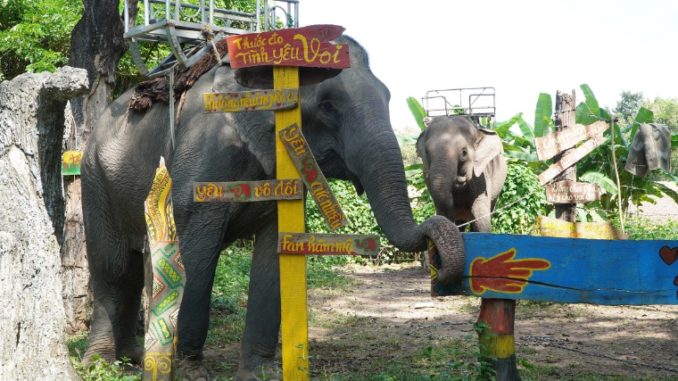
DAK LAK – Eman’s long house in the Buon Don tourist area holds many documentary photos and tools for hunting forest elephants in the past.

The long house Eman (elephant house) in the Buon Don tourist area has an area of about 100 m2, containing hundreds of documents, images, objects, jewelry… related to elephants. For ethnic groups in the Central Highlands, elephants are considered as a family member, a sacred symbol, symbolizing the power, material and spiritual strength of the village.

The painting depicting the Gru (heroes) hunting wild elephants is displayed in the elephant house.

Documentary photo of the elephant team of Royal Bao Dai. When he was alive, King Bao Dai had a hobby of hunting. There are trips lasting nearly a month, with more than 100 people serving as guards, weapons bearers, food carriers, drivers …
Dynasties such as Ngo, Dinh, Le, Ly, Tran, Le… often used elephants in royal activities. Elephants in the capital are called Kinh Kinh, used to guard important places, take the lead in processions, royal festivals, and carry kings and officials.

Portrait of elephant hunter Y Thu Knul, born in 1820 (110 years old). He was the one who gave birth to the place of Ban Don, and had great merit in the early establishment and development of hunting and taming wild elephants (with buffalo leather straps).
He once caught about 400 elephants, and was the most prestigious and richest Chief in the region, honored by the tribal chiefs in the Central Highlands in 1861, when he caught the white elephant (white elephant, worth 100 heads). black elephant). He was conferred the title of Khunsanup by the King of Thailand – the king of hunting elephants. Photo: Documentation

In 1995, the state banned hunting and domestication of wild elephants. Kham Bun (meaning beautiful tusks) is the last elephant captured by the Gru, once chosen as the ending image of a 13-volume series of memoirs about Dak Lak. In 2007, Bun was transferred to the Vietnam Circus Federation (Hanoi) and died three years later when he was only 6 years old (average elephant age 50 years). Photo: Documentation

According to H’Mi, a guide at the resort, in the elephant taming tools, the elephant hunter’s cape is noticed by tourists. The robes are made of the bark of the sesame tree, used to deodorize the body, so that hunters will not be detected by wild elephants.

Rope made of buffalo skin, dried for 12 months. Horns and buffalo horns, used to signal hunters while hunting. In addition, the horn is also used to draw water to drink when thirsty.

The elephant armchair is usually made of a wooden frame and rattan rope; When carrying people and belongings, the armchair is tied on the back of the elephant. Banh help stabilize, do not tilt when elephants go fast or up and down steep hills, people use big rattan ropes, put them on the elephant’s neck, tail, belly, armpit. Besides the umbrella, there is also a roof to cover the rain and sun, which the people call kuk.

Two elephant graves are worshiped in the tourist area. The elephant Paku (left) was caught by G’ru (elephant hunters) in Ban Don in the summer of 1978. After 6 months of domestication, this elephant began to integrate with the village’s elephants. In 2010, Packu was killed by a group of people with gasoline and slashed 217 times.
H’Panh elephant was caught by Mr. Ama Kong in 1995. In May 2010, when he was released into the forest to eat, H’Panh collapsed and died at the age of 55.

In the resort’s premises, visitors also learn about many spiritual knowledge related to elephants.

Two elephants serve tourists to take souvenir photos.
According to the Dak Lak Elephant Conservation Center, there are 37 domestic elephants left in the province, of which there are 22 individuals in the Buon Don district, 14 individuals in the Lak district and one individual in the Krong Ana district.
Photo: Internet (vinlove.net)
